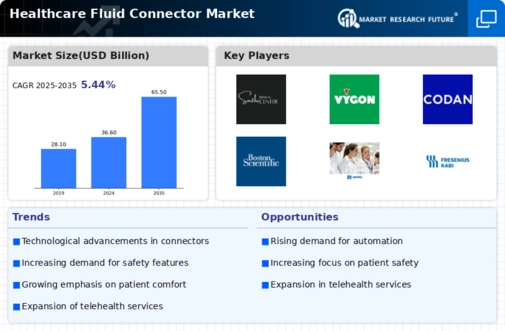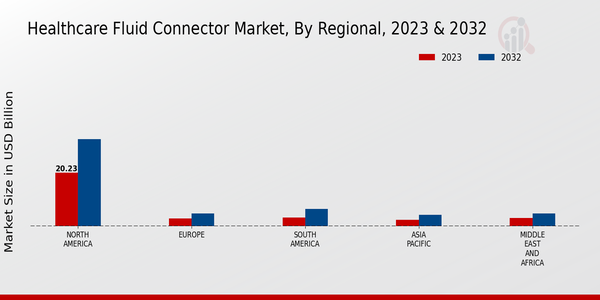Aging Population
The aging population is a crucial driver of the Global Healthcare Fluid Connector Market Industry. As the global demographic shifts towards an older population, the prevalence of chronic diseases and the need for medical interventions increase. This demographic trend necessitates the use of various medical devices that rely on fluid connectors for effective treatment. The growing number of elderly patients requiring continuous care and monitoring amplifies the demand for reliable fluid management solutions. Consequently, the market is poised for growth as healthcare providers adapt to the needs of an aging population, ensuring that fluid connectors remain integral to patient care.
Market Growth Projections
The Global Healthcare Fluid Connector Market Industry is projected to experience substantial growth over the coming years. With a market size anticipated to reach 36.6 USD Billion in 2024 and further expand to 65.5 USD Billion by 2035, the industry is poised for a robust trajectory. The compound annual growth rate of 5.44% from 2025 to 2035 indicates a sustained demand for fluid connectors across various healthcare applications. This growth is driven by factors such as technological advancements, increasing healthcare expenditure, and the rising prevalence of chronic diseases. The market's expansion reflects the critical role that fluid connectors play in modern healthcare.
Technological Advancements
Technological advancements play a pivotal role in shaping the Global Healthcare Fluid Connector Market Industry. Innovations such as smart connectors and automated systems are enhancing the efficiency and reliability of fluid management in healthcare applications. These advancements not only improve patient outcomes but also streamline operational processes within healthcare facilities. The anticipated growth of the market, projected to reach 65.5 USD Billion by 2035, underscores the importance of continuous innovation in fluid connector technology. As healthcare providers seek to optimize their operations, the demand for advanced fluid connectors is likely to rise, further propelling market expansion.
Increasing Healthcare Expenditure
The Global Healthcare Fluid Connector Market Industry is significantly influenced by rising healthcare expenditure across various regions. Governments and private sectors are investing heavily in healthcare infrastructure, leading to an increased demand for medical devices and accessories, including fluid connectors. This trend is particularly evident in emerging economies, where healthcare spending is expected to grow substantially. The projected compound annual growth rate of 5.44% from 2025 to 2035 highlights the potential for market growth driven by increased investment in healthcare services and technology. As healthcare systems expand, the need for efficient fluid management solutions becomes increasingly critical.
Rising Demand for Medical Devices
The Global Healthcare Fluid Connector Market Industry is experiencing a surge in demand for medical devices, driven by advancements in healthcare technology and an increasing focus on patient safety. As healthcare systems evolve, the need for reliable fluid connectors in devices such as IV systems, catheters, and surgical instruments becomes paramount. This trend is reflected in the projected market size of 36.6 USD Billion in 2024, indicating a robust growth trajectory. The integration of innovative materials and designs enhances the functionality and safety of these connectors, thereby fostering their adoption across various healthcare settings.
Regulatory Compliance and Standards
Regulatory compliance and standards significantly impact the Global Healthcare Fluid Connector Market Industry. Stringent regulations governing medical devices necessitate that manufacturers adhere to specific quality and safety standards. This compliance ensures that fluid connectors are reliable and safe for use in healthcare settings. As regulatory bodies continue to evolve their guidelines, manufacturers are compelled to innovate and improve their products to meet these standards. This dynamic creates opportunities for growth within the market, as companies that prioritize compliance are likely to gain a competitive edge. The ongoing emphasis on safety and quality is expected to drive demand for advanced fluid connector solutions.


 Source: Primary Research, Secondary Research, Market Research Future Database and Analyst Review
Source: Primary Research, Secondary Research, Market Research Future Database and Analyst Review







